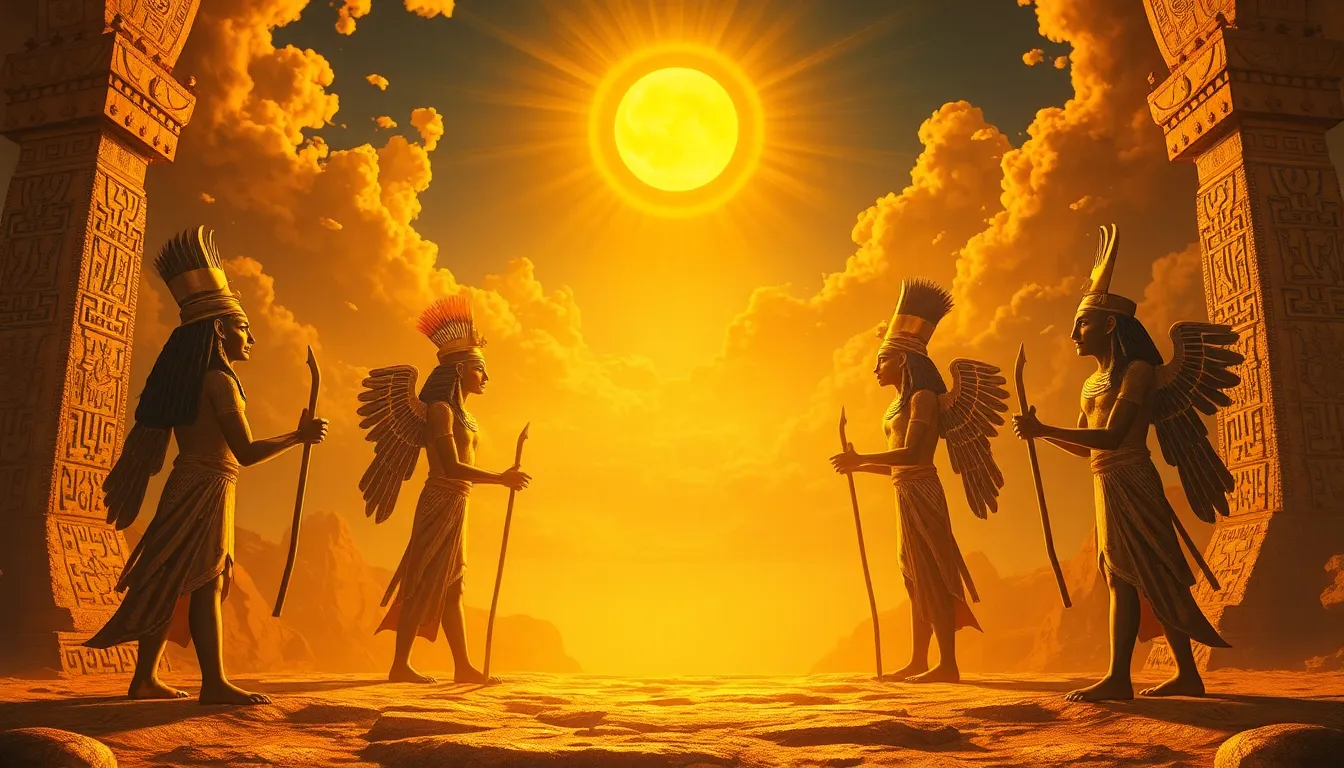The Myth of Ra’s Children: The Solar Deities
I. Introduction
In the rich tapestry of Egyptian mythology, few deities hold as much significance as Ra, the supreme solar deity. He embodies the life-giving power of the sun and serves as a central figure in numerous myths and religious practices. The solar deities, often considered manifestations of Ra, play pivotal roles in ancient Egyptian culture, influencing everything from daily life to the afterlife.
This article aims to explore the myths surrounding Ra’s children, examining their attributes, their roles in the cosmos, and their lasting impact on Egyptian culture and beyond.
II. Ra: The Supreme Solar Deity
Ra, often depicted with a falcon head encircled by a solar disk, is one of the most important deities in ancient Egypt. His origins are steeped in creation myths, where he is credited with bringing forth life from the primordial waters of Nun.
Ra’s attributes include:
- Symbol of the sun and light
- God of creation and order
- Protector of the pharaohs and the nation
In creation myths, Ra is often portrayed as the first being, who creates other gods and the universe itself. The sun symbolizes not only physical light but also knowledge and truth, making Ra a cornerstone of Egyptian belief systems.
III. The Children of Ra: An Overview
Ra’s offspring are significant figures in their own right, embodying various aspects of life, nature, and the cosmos. The familial relationships among these deities illustrate the interconnectedness of their roles within the pantheon.
Key points about Ra’s children include:
- They often represent different elements of the sun’s power.
- Their myths reflect the complexities of order, chaos, and human experience.
- Many solar deities are considered manifestations of Ra, showing his expansive influence.
IV. Key Solar Deities and Their Myths
Among Ra’s children, several deities stand out due to their unique attributes and compelling myths:
A. Horus: The Falcon God and Avenger
Horus, the son of Isis and Osiris, is often depicted as a falcon or a man with a falcon’s head. He embodies kingship and the sky, representing the living pharaoh on earth. His myth revolves around avenging the death of his father, Osiris, and his battles with Set, the god of chaos.
B. Hathor: The Goddess of Love and Joy
Hathor, often represented as a cow or a woman with cow horns, is the goddess of love, beauty, music, and motherhood. She is a nurturing figure who brings joy and fertility, signifying the sun’s life-giving aspects.
C. Set: The God of Chaos and Desert
Set is a complex figure, often seen as the god of chaos, storms, and the desert. While he represents disorder, his role in the mythology is crucial, as he balances the order represented by Horus. Set’s battles with Horus are symbolic of the struggle between chaos and order.
D. Other Notable Solar Deities
- Sekhmet: The lioness goddess of war and healing, embodying the destructive and protective aspects of the sun.
- Khonsu: The moon god, often associated with time and healing, illustrating the relationship between solar and lunar deities.
V. The Role of Solar Deities in Egyptian Cosmology
Solar deities are integral to the understanding of Egyptian cosmology. They represent:
- The balance between order (Ma’at) and chaos (Isfet).
- The cycles of life, death, and rebirth, particularly through the daily journey of the sun across the sky.
- The relationship between solar (day) and lunar (night) deities, symbolizing the duality of existence.
VI. The Worship and Cult of Ra’s Children
The worship of Ra and his children was central to ancient Egyptian religion. Temples dedicated to solar deities were prominent across the landscape, with rituals and festivals celebrating their attributes:
- Temples: Sacred spaces like the Temple of Karnak were dedicated to Ra, where daily rituals ensured the sun would rise.
- Festivals: Celebrations such as Wepet-Renpet marked the new year and the rebirth of the sun.
- Priests and Priestesses: These individuals played vital roles in maintaining the rituals and ensuring the favor of the gods.
VII. Legacy and Influence of Ra’s Children
The impact of solar deities extends beyond ancient Egypt. Their myths have influenced various cultures and artistic representations throughout history:
- Solar deities have appeared in art, literature, and architecture, symbolizing power and divinity.
- Modern interpretations often draw on these myths to explore themes of light and darkness.
- The legacy of Ra’s children continues to resonate in contemporary spiritual practices and popular culture.
VIII. Conclusion
In summary, Ra’s children represent a complex web of relationships and attributes that shaped ancient Egyptian mythology. Their stories illustrate the balance of order and chaos, the cycles of life, and the importance of familial ties among the deities.
The enduring legacy of these solar deities provides insight into the belief systems of ancient Egyptians and their understanding of the universe. The myths surrounding Ra’s children continue to inspire and inform modern interpretations, reflecting the timeless nature of these ancient narratives.




